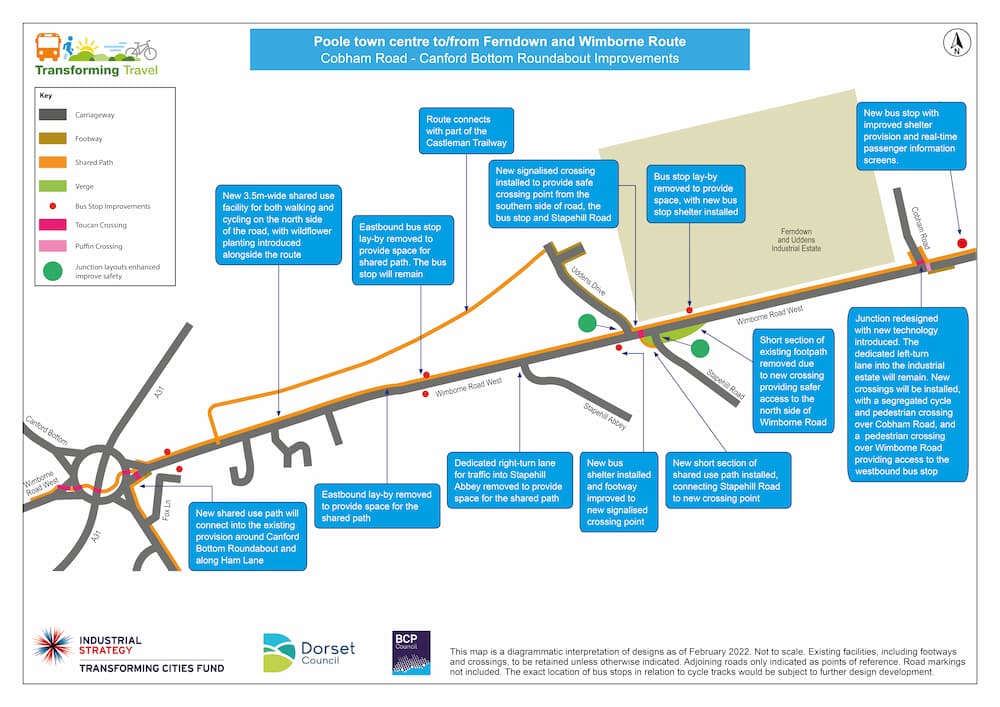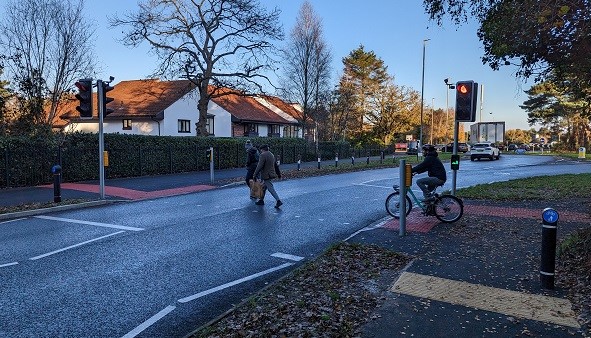
View the latest roadworks on our map
This project provides a safe, sustainable transport link between residential areas, local schools, and centres of employment like Ferndown town centre and Ferndown Industrial Estate. The improvements aim to transform local travel, help to reduce road congestion and pollution, improve air quality, and bring economic and health benefits.
This forms part of the sustainable travel route between Poole town centre, Ferndown and Wimborne.
The project provides 7km (4.3 miles) of uninterrupted access from Wimborne to Trickett’s Cross, linking populated residential areas with the biggest employment area in Dorset.
This concludes the better routes for cycling and walking on Wimborne Road East, Ferndown, enabling a safer, more accessible route that will make it easier for people get around the area when walking, cycling, wheeling or taking the bus.
What work took place
This project was broken down into 3 phases.
Phase 1
Wimborne Road West from Canford Bottom Roundabout to Cobham Road.
Plans illustrating the phases
Phase 1:

Request this infographic in a different format.
Improvements along the 1.5km section of Wimborne Road West, between Canford Bottom Roundabout and Cobham Road:
- a new 3.5m-wide shared use facility for walking and cycling installed on the north side of the road, with wildflower planting introduced along the route. This connects into the Castleman Trailway and the existing provision on Canford Bottom Roundabout
- two bus stop laybys and one regular layby on the north side of the road were removed to provide space for the shared path
- bus stops along the route were upgraded, with new shelters and real time information introduced, and accessibility improvements made
- dedicated right-turn lane for traffic into Stapehill Abbey was removed to provide space for a shared path. Vehicles can still turn right into the road
- improvements at the Stapehill Road and Uddens Drive junctions, with layouts enhanced to improve safety and a new signalised crossing point. A short section of existing footpath on the south side of the road, near Stapehill Road, was removed. This is because the new crossing provides safer access to the north side of Wimborne Road West
Phase 2:
Wimborne Road East between Trickett's Cross Roundabout and West Moors Road.
Request this infographic in a different format.

The new toucan crossing on Wimborne Road East.
Improvements along the 800m section of Wimborne Road West, between Trickett’s Cross Roundabout and West Moors Road:
- the existing footway on the north side of Wimborne Road East was widened and converted to a 3m-wide shared use facility for both walking and cycling. This is located between Trickett’s Cross Roundabout and Martins Drive. The shared path has priority over adjoining roads
- a new toucan crossing was installed by Trickett’s Cross roundabout, connecting the proposed provision on Ringwood Road to the new shared path
- a new central island was installed near Woodland Walk
- improvements were made for pedestrians at the junctions of adjoining roads on the south side of Wimborne Road East, including dropped kerbs and tactile paving
- a new two-way cycle track was installed, separated from the existing footpath, between Martins Drive and the western end of the Wimborne Road service road. The area was landscaped with tree planting and wildflower areas
- the bus stops along the route were upgraded with new shelters, real time information and accessibility improvements. The eastbound bus stop near Badgers Walk was relocated slightly further east. The layby was removed to provide space for the shared path
Phase 3:
Improvements along the 2km section of Wimborne Road East, between Cobham Junction and West Moors Road were split into 2 sections.
Phase 3a (from the east of Stanfield Road to West Moors Road).
Phase 3b (between Stanfield Road and Brickyard Lane). This was funded through the Active Travel Fund administered by Active Travel England.
Phase 3a and 3b
Request this infographic in a different format.
Phase 3a included:
- Cobham Road junction redesigned with new technology
- new crossings, with a segregated cycle and pedestrian crossing over Cobham Road and a pedestrian crossing over Wimborne Road providing access to the westbound bus stop
- new cycle and walking paths along the north side of Wimborne Road East
- upgraded bus stops
- upgrade existing pedestrian crossing outside the Pure Drop Inn
- re-modelling and introduction of new technology to traffic lights and crossings at the junctions of:
- Ameysford Rd/Church Road
- Queens Road/Victoria Road
- West Moors Road
Phase 3b
The improvements included:
- construction of new cycle and walking paths along the north side of Wimborne Road East, with priority over adjoining roads
- upgrading the existing signal-controlled crossing near Stanfield Road at the School pedestrian/cycle access
- upgrading bus stops
Construction
While construction took place, there was traffic management to protect both the public and the workforce. Work was completed in sections, with temporary one-way closures and traffic signals in place.
Affected residents were informed by letter of any road closures for resurfacing during the works. The closures were also signposted.
About the area
Across the Ferndown and Wimborne area, one in eight households does not have access to a vehicle. This represents thousands of residents who would benefit from safer more accessible routes to be able to get around by walking, wheeling, bus and cycling.
Of the 1700 children who attend Ferndown First, Middle and Upper schools, 700 children are currently driven to school. Safer, continuous routes to link to the schools will enable more parents to have the confidence to allow their children to travel on foot, scooter and bike to school.
Helping to reduce local congestion, reducing emissions and giving children the greater opportunities to be active and independent – see figure 1 below. If Ferndown replicated travel patterns in Cambridge, 750 children would be cycling to these schools, saving around 40 tonnes of CO2 per year.
Over 4,500 people commute to the part of Ferndown that includes the industrial estates and schools. 90% of these people currently commute by car. Providing continuous, safe, footways and cycleways will enable more of these residents to choose alternative modes, helping to reduce local congestion and enable a switch to healthier lifestyles.
1 in 5 residents of Dorset are not physically active for more than 30 minutes a week. Enabling a safe active travel network around where people live will help people to be able to build physical activity more easily into their daily lives, gaining substantial health benefits.
Transforming Travel project team
Email: transformingtravel@dorsetcouncil.gov.ukFull contact details
